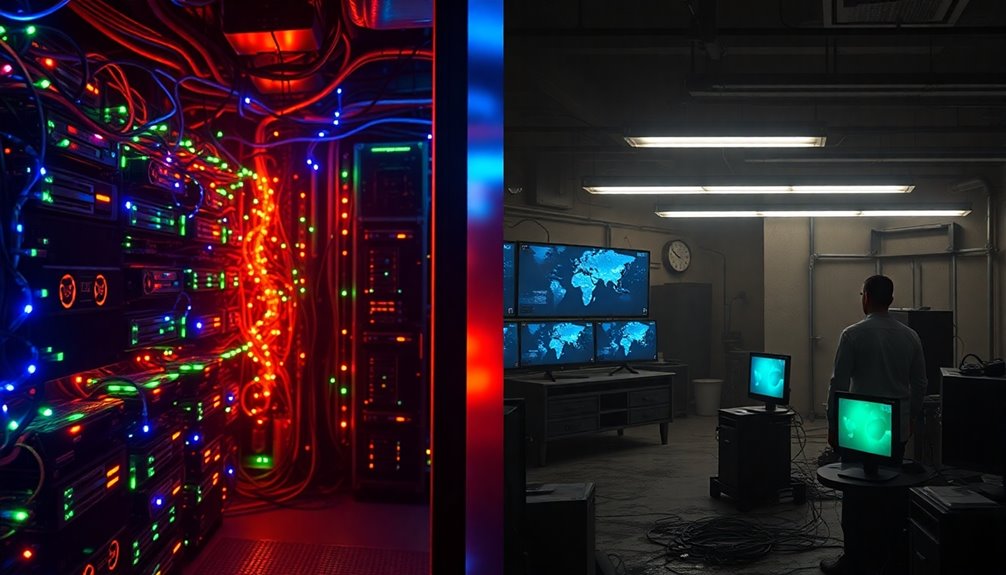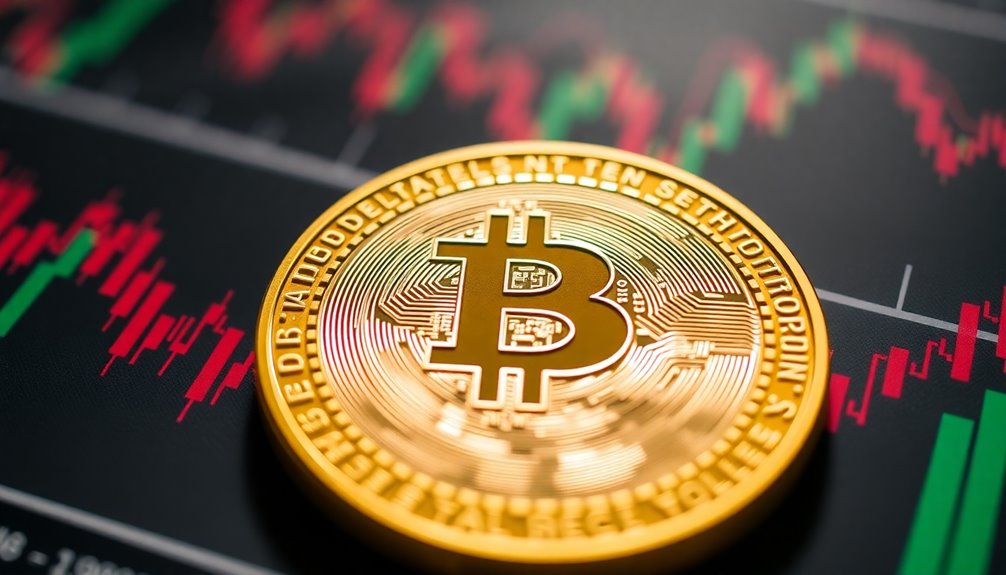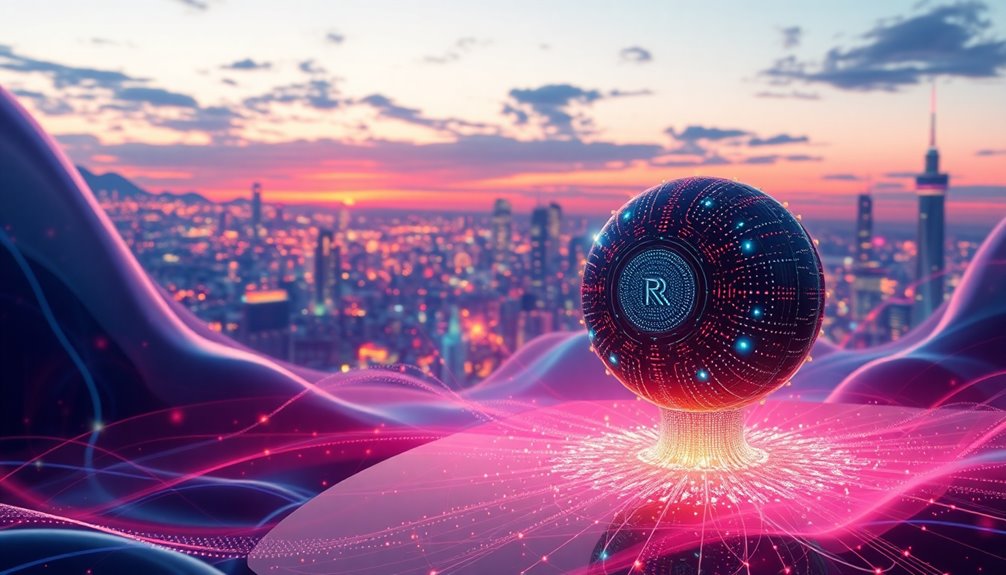Render Crypto, or RNDR, is a decentralized network that connects you with unused GPU power for efficient rendering tasks. By utilizing blockchain technology, it offers transparent and secure transactions and uses a sophisticated algorithm to distribute workloads across available GPUs. This network reduces costs and time significantly, making it a game-changer for creators in gaming, architecture, and more. You can pay with RNDR tokens, which adjust dynamically based on workload. As the demand for high-definition rendering rises, Render Crypto's relevance grows. Stick around, and you'll discover even more about its unique features and potential benefits.
Key Takeaways
- Render Crypto, or RNDR, is a utility token used for transactions within the Render Network, primarily for GPU rendering tasks.
- It operates on the Ethereum blockchain, ensuring transparency and security through smart contracts.
- The network connects creators with underutilized GPU power, facilitating efficient rendering for 3D animation and augmented reality projects.
- RNDR tokens are capped at 536,870,912, with dynamic pricing based on GPU workload, allowing flexible payment options.
- The Render Network enhances security and efficiency across industries like gaming and architecture through its decentralized peer-to-peer marketplace.
Core Concepts Explained Succinctly

When you dive into the Render Network, you'll quickly discover how blockchain technology transforms rendering services. This network integrates blockchain to ensure transparency and security, recording every rendering task on a public ledger. By connecting underutilized GPU power with creators needing rendering for 3D animation or augmented reality, it optimizes efficiency. You'll also find that the RENDER token, based on Ethereum, facilitates transactions while a dynamic pricing system adjusts costs based on GPU workload(main factual point). Each project submission triggers a sophisticated algorithm that distributes tasks among GPUs, ensuring timely completion. With escrow contracts safeguarding payments and a proof-of-render validation system, you can trust that your projects are handled securely and efficiently.
Overview of Render Crypto

The Render Network revolutionizes rendering services by integrating cryptocurrency, particularly through its RNDR token. With a capped supply of 536,870,912 RNDR tokens, 25% was sold to the public, while 65% remains in escrow to manage supply and demand. Utilizing the Ethereum blockchain, the network ensures transaction transparency and security through smart contracts and a Proof-of-Render governance system that rewards node operators for their contributions. RNDR credits allow creators to purchase rendering power via PayPal and Stripe, enhancing accessibility. The network operates on a peer-to-peer model, employing a dynamic pricing system and advanced matchmaking algorithms for efficient job allocation. This structure empowers users across industries, democratizing high-quality rendering solutions while maintaining cost-efficiency and scalability. Additionally, the growing demand for high-definition experiences drives the need for innovative rendering solutions like those offered by the Render Network.
Decentralized Rendering Network Explained

Understanding the Decentralized Rendering Network requires recognizing its innovative architecture that connects users in a peer-to-peer GPU marketplace. Here, you can upload your 3D rendering projects while Node Operators provide the necessary GPU power. Operating on the Ethereum blockchain, the network employs smart contracts to ensure secure and transparent transactions. The Render Network, founded in 2017 by Jules Urbach, is designed to leverage blockchain for transforming graphics rendering. When you submit a project, the system distributes the workload across available GPUs using a sophisticated algorithm. The chosen GPU then renders your design, verified through a "Proof of Render" system. You'll pay Node Operators in RENDER tokens, with costs determined by a dynamic pricing model based on workload. This decentralized approach enhances security, efficiency, and accessibility for various industries, from gaming to architecture.
Pros and Cons Overview

While exploring Render Crypto, it's essential to weigh both its advantages and drawbacks.
On the plus side, you can benefit from cost-efficiency and speed, accessing a decentralized pool of GPU resources that can cut rendering costs and time by up to 90%. The blockchain foundation enhances security and transparency, ensuring fair compensation and reducing GPU wastage. Additionally, the increasing demand for GPU services due to AI development further supports Render's market potential.
However, market volatility poses a risk, as price fluctuations can affect adoption and investment predictability. Additionally, technical challenges like scalability and data privacy concerns may limit growth.
Finally, regulatory hurdles could impact operations. Balancing these pros and cons helps you make informed decisions about engaging with Render Crypto.
Render vs. Traditional Rendering

Render Crypto offers a fresh alternative to traditional rendering methods that can be costly and time-consuming. By utilizing a decentralized network of computers, it taps into unused GPU power from home devices, drastically reducing costs and increasing efficiency. This method allows for the implementation of advanced techniques that enhance the quality of rendered images.
Instead of relying on expensive rendering farms, you can submit jobs to the Render Network, which operates on the Ethereum blockchain for transparency. This approach not only speeds up rendering processes by distributing tasks across multiple GPUs, but it also supports various advanced techniques like ray tracing and rasterization.
Plus, you can earn Render tokens (RNDR) by contributing your GPU power, making high-quality rendering accessible to a broader range of users. It's a game-changer for artists and designers alike.
Market Volatility Concerns

As the cryptocurrency market continues to evolve, concerns about volatility can significantly impact your investment decisions.
Render Token's historical volatility, with a standard deviation of 7.28 and a variance of 52.93, reflects its price fluctuations. With a beta of 1.62 against the Dow Jones, it's sensitive to market movements, often mirroring Bitcoin's trends. Recent price action shows a staggering 29% gain in a week, but don't overlook the sharp 24.21% drop within that time. The Sharpe Ratio of 0.0729 indicates modest returns relative to the risk you're taking. Additionally, Render Token's high volatility suggests potential for both significant gains and losses, emphasizing the need for careful risk management.
Increased whale activity and high trading volumes signal market confidence, but always be cautious of the potential for sudden price swings that could affect your investments.
Emergence of Ai-Driven Rendering

With the rapid advancement of technology, AI-driven rendering is transforming how visuals are created and experienced.
You'll find that neural networks, especially Generative Adversarial Networks (GANs), enhance realism by analyzing vast datasets to improve rendering accuracy. These AI models mimic how our brains recognize patterns, allowing for optimal light paths and textures.
Ray tracing algorithms, powered by AI, simulate light interactions more accurately, producing lifelike reflections and shadows. This technology also cuts rendering times dramatically, turning hours into minutes. Traditional rendering times have been drastically reduced, enabling faster delivery of stunning visuals.
Plus, it automates complex tasks, freeing you from repetitive adjustments. The result? You get photorealistic visuals and vibrant details, making your projects stand out in fields like architecture, gaming, and product design.
Optimize GPU Usage Effectively

Optimizing GPU usage effectively is crucial for achieving peak performance in rendering tasks. Start by adjusting batch sizes; larger batches can boost GPU utilization but may increase memory consumption. Test various sizes to find the right balance, and consider dynamic batch sizing to adapt automatically based on memory availability.
Utilize mixed precision training to enhance efficiency—using lower-precision data types like float16 can reduce computation time without sacrificing accuracy. Distribute workloads across multiple GPUs to ensure balanced resource usage, employing tools like Horovod or PyTorch's DistributedDataParallel. Monitoring GPU utilization can help identify areas for improvement and ensure resources are used effectively.
Finally, optimize data pipelines by implementing prefetching and multi-threading techniques to eliminate bottlenecks, ensuring your GPUs stay fully occupied and perform at their best.
Frequently Asked Questions
How Does Render Crypto Ensure Security for Transactions?
Render Crypto ensures security for transactions through blockchain integration and smart contracts.
By logging every rendering task immutably, you gain transparency and protection against fraud.
Smart contracts automate payments, reducing disputes and enforcing agreed terms.
The decentralized network eliminates single points of failure, enhancing resilience against attacks.
Plus, compliance with KYC and AML protocols builds trust, ensuring your transactions are secure and legitimate within the ecosystem.
What Types of Projects Can Benefit From Render Crypto?
Imagine a bustling marketplace where artists showcase their vivid creations.
Just like these artists, various projects thrive on high-quality visuals. Whether you're crafting a stunning video game, designing a breathtaking building, or launching an eye-catching marketing campaign, you need powerful rendering tools.
You can transform ideas into reality, accelerate research with complex simulations, and elevate your creative endeavors, all while saving time and money with scalable rendering solutions.
Are There Fees Associated With Using Render Crypto Services?
Yes, there are fees associated with using Render Crypto services.
You'll encounter withdrawal fees, which vary from 0.1 RENDER to as high as 8.85 RENDER, depending on the platform.
Transaction fees also apply to support network operations and compensate node operators.
Additionally, rendering service fees are structured by tiers, with costs influenced by the complexity of your tasks.
Keep in mind that market volatility can further affect these fees and overall expenses.
Can Render Crypto Integrate With Existing Software Tools?
Absolutely, Render Crypto can integrate seamlessly with existing software tools.
You'll find it compatible with popular 3D content creation applications, thanks to its foundation on OctaneRender and support for the ORBX format.
By utilizing the Octane SDK, you can expand its functionality to fit your workflow.
This integration allows you to take advantage of parallel processing and efficient rendering, enhancing your projects' speed and quality without disrupting your current processes.
What Is the Future Outlook for Render Crypto in the Market?
The future outlook for Render crypto is bright, yet uncertain.
You'll see predictions suggesting it could soar to $82.08 by 2035, driven by partnerships and growing demand for decentralized computing.
However, market volatility and regulatory changes could also pose risks.
With increasing institutional interest and a rising number of active addresses, it's clear that Render has potential, but staying informed and cautious is key as you navigate this evolving landscape.
Conclusion
In summary, Render Crypto offers a revolutionary approach to rendering that leverages decentralized networks, making it a game-changer in the tech landscape. While it has its pros and cons, it stands tall against traditional rendering methods, especially with the rise of AI-driven techniques. Just like the steam engine transformed industries in the past, Render Crypto is poised to redefine digital content creation. Embrace this shift, and you'll unlock new possibilities for efficient GPU usage and creativity.









